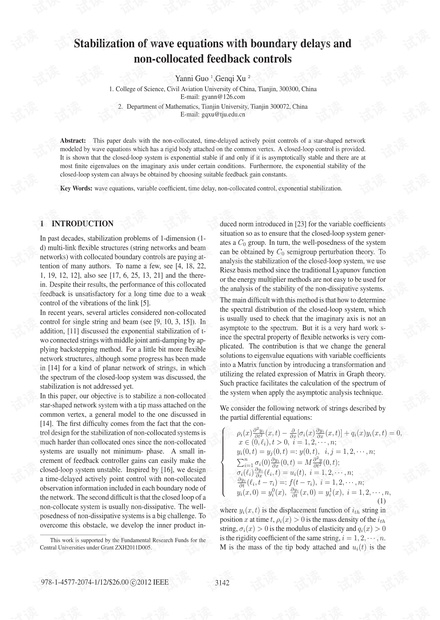
Stabilization of wave equations with boundary delays and
non-collocated feedback controls
Yanni Guo
1
,Genqi Xu
2
1. College of Science, Civil Aviation University of China, Tianjin, 300300, China
E-mail: gyann@126.com
2. Department of Mathematics, Tianjin University, Tianjin 300072, China
E-mail: gqxu@tju.edu.cn
Abstract: This paper deals with the non-collocated, time-delayed actively point controls of a star-shaped network
modeled by wave equations which has a rigid body attached on the common vertex. A closed-loop control is provided.
It is shown that the closed-loop system is exponential stable if and only if it is asymptotically stable and there are at
most finite eigenvalues on the imaginary axis under certain conditions. Furthermore, the exponential stability of the
closed-loop system can always be obtained by choosing suitable feedback gain constants.
Key Words: wave equations, variable coefficient, time delay, non-collocated control, exponential stabilization.
1 INTRODUCTION
In past decades, stabilization problems of 1-dimension (1-
d) multi-link flexible structures (string networks and beam
networks) with collocated boundary controls are paying at-
tention of many authors. To name a few, see [4, 18, 22,
1, 19, 12, 12], also see [17, 6, 25, 13, 21] and the there-
in. Despite their results, the performance of this collocated
feedback is unsatisfactory for a long time due to a weak
control of the vibrations of the link [5].
In recent years, several articles considered non-collocated
control for single string and beam (see [9, 10, 3, 15]). In
addition, [11] discussed the exponential stabilization of t-
wo connected strings with middle joint anti-damping by ap-
plying backstepping method. For a little bit more flexible
network structures, although some progress has been made
in [14] for a kind of planar network of strings, in which
the spectrum of the closed-loop system was discussed, the
stabilization is not addressed yet.
In this paper, our objective is to stabilize a non-collocated
star-shaped network system with a tip mass attached on the
common vertex, a general model to the one discussed in
[14]. The first difficulty comes from the fact that the con-
trol design for the stabilization of non-collocated systems is
much harder than collocated ones since the non-collocated
systems are usually not minimum- phase. A small in-
crement of feedback controller gains can easily make the
closed-loop system unstable. Inspired by [16], we design
a time-delayed actively point control with non-collocated
observation information included in each boundary node of
the network. The second difficult is that the closed loop of a
non-collocate system is usually non-dissipative. The well-
posedness of non-dissipative systems is a big challenge. To
overcome this obstacle, we develop the inner product in-
This work is supported by the Fundamental Research Funds for the
Central Universities under Grant ZXH2011D005.
duced norm introduced in [23] for the variable coefficients
situation so as to ensure that the closed-loop system gener-
ates a 𝐶
0
group. In turn, the well-posedness of the system
can be obtained by 𝐶
0
semigroup perturbation theory. To
analysis the stabilization of the closed-loop system, we use
Riesz basis method since the traditional Lyapunov function
or the energy multiplier methods are not easy to be used for
the analysis of the stability of the non-dissipative systems.
The main difficult with this method is that how to determine
the spectral distribution of the closed-loop system, which
is usually used to check that the imaginary axis is not an
asymptote to the spectrum. But it is a very hard work s-
ince the spectral property of flexible networks is very com-
plicated. The contribution is that we change the general
solutions to eigenvalue equations with variable coefficients
into a Matrix function by introducing a transformation and
utilizing the related expression of Matrix in Graph theory.
Such practice facilitates the calculation of the spectrum of
the system when apply the asymptotic analysis technique.
We consider the following network of strings described by
the partial differential equations:
𝜌
𝑖
(𝑥)
∂
2
𝑦
𝑖
∂𝑡
2
(𝑥, 𝑡) −
∂
∂𝑥
[𝜎
𝑖
(𝑥)
∂𝑦
𝑖
∂𝑥
(𝑥, 𝑡)] + 𝑞
𝑖
(𝑥)𝑦
𝑖
(𝑥, 𝑡)=0,
𝑥 ∈ (0,ℓ
𝑖
),𝑡>0,𝑖=1, 2, ⋅⋅⋅,𝑛;
𝑦
𝑖
(0,𝑡)=𝑦
𝑗
(0,𝑡)=:𝑦(0,𝑡),𝑖,𝑗=1, 2, ⋅⋅⋅,𝑛;
𝑛
𝑖=1
𝜎
𝑖
(0)
∂𝑦
𝑖
∂𝑥
(0,𝑡)=𝑀
∂
2
𝑦
∂𝑡
2
(0,𝑡);
𝜎
𝑖
(ℓ
𝑖
)
∂𝑦
𝑖
∂𝑥
(ℓ
𝑖
,𝑡)=𝑢
𝑖
(𝑡),𝑖=1, 2, ⋅⋅⋅,𝑛;
∂𝑦
𝑖
∂𝑡
(ℓ
𝑖
,𝑡− 𝜏
𝑖
)=:𝑓 (𝑡 − 𝜏
𝑖
),𝑖=1, 2, ⋅⋅⋅,𝑛;
𝑦
𝑖
(𝑥, 0) = 𝑦
0
𝑖
(𝑥),
∂𝑦
𝑖
∂𝑡
(𝑥, 0) = 𝑦
1
𝑖
(𝑥),𝑖=1, 2, ⋅⋅⋅,𝑛,
(1)
where 𝑦
𝑖
(𝑥, 𝑡) is the displacement function of 𝑖
𝑡ℎ
string in
position 𝑥 at time 𝑡, 𝜌
𝑖
(𝑥) > 0 is the mass density of the 𝑖
𝑡ℎ
string, 𝜎
𝑖
(𝑥) > 0 is the modulus of elasticity and 𝑞
𝑖
(𝑥) > 0
is the rigidity coefficient of the same string, 𝑖 =1, 2, ⋅⋅⋅,𝑛.
M is the mass of the tip body attached and 𝑢
𝑖
(𝑡) is the
3142
978-1-4577-2074-1/12/$26.00
c
2012 IEEE
















